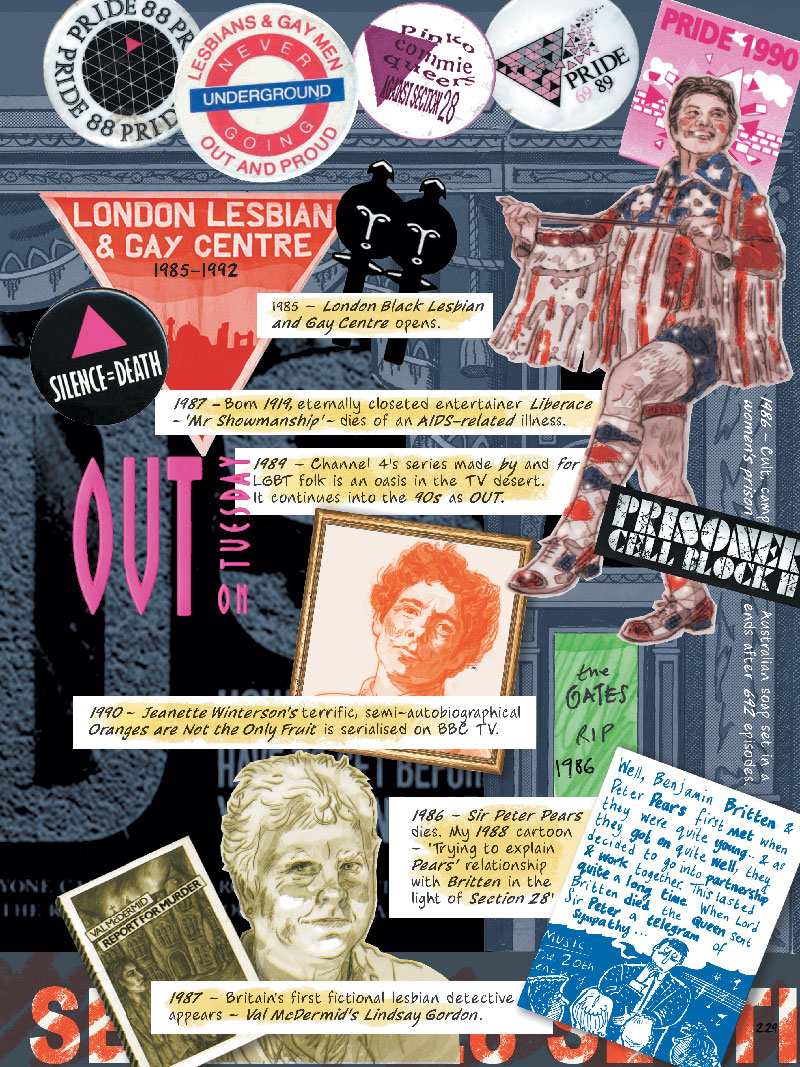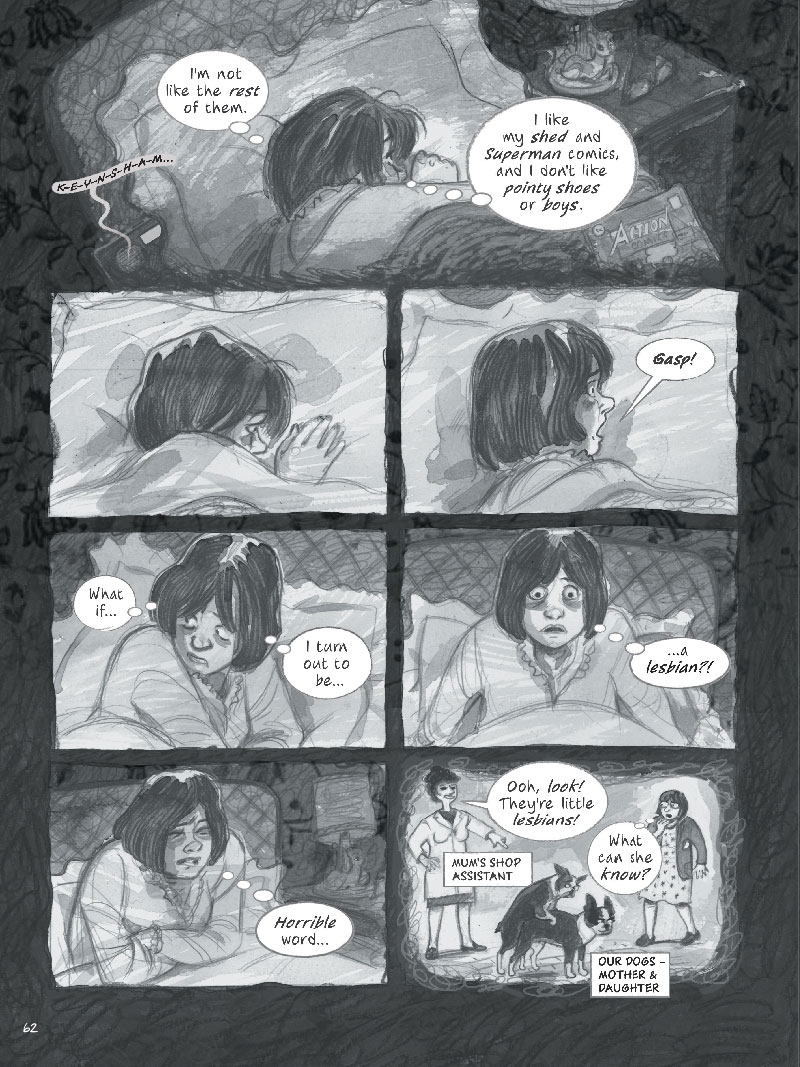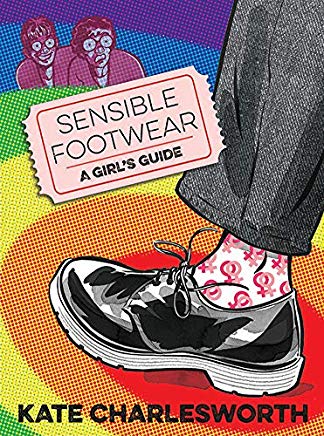Sensible Footwear, A Girl’s Guide (£17-99, Myriad) by Kate Charlesworth.
“FEMINISM IS THE RADICAL IDEA THAT WOMEN ARE PEOPLE”
IS THE RADICAL IDEA THAT WOMEN ARE PEOPLE”
What a superbly structured, brilliant but biting history and vital entertainment this is!
Shoes! Shoes! Sensible shoes!
You are hereby ever so warmly invited to walk a mile or twenty-six in somebody else’s – Kate Charlesworth’s and the growing LGBT+ community’s – in a personal insight, education and entertainment spanning 70 years from the 1950s onwards!
All education should be an entertainment and this one comes vibrant in colour, comedy and variety without a po face in sight:
“Yes, Cinders!” it proudly proclaims on its title page, “You shall go to the Rugmunchers’ Ball!”
It is laugh! It’s a riot! It is a genuine milestone.
It is a declaration of unequivocal and inalienable pride and ownership, as well as an acknowledgement of childhood innocence and naivety which is overwhelmingly inclusive because, hey, weren’t we all – gay or straight – utterly baffled and confused aged 5, 7, 9 or 11 either by what others have got going on down there or by increasingly wild, schoolyard hearsay when it came to matters of love and sexual congress? Of course we were!
You’ll be privy to Kate’s own mystification then awkward, uh-oh education; the disinformation then elucidation; timidity, discovery, further confusion and gradually figuring it out. It’s never a straight learning curve, is it? Now imagine all that… before the age of internet information! Before the love that dared not speak its name spoke its name! Before you might know where to go, or whom you could confide in, ever so carefully even those closest to you!
Because ostracism is a bitch, and its prospect’s pretty daunting; potentially even more so when they’re your friends.
But this is mischievous, it’s irreverent and I did promise you “variety”. I meant it in both senses for as well as a personal reflection – shared between four fast friends in the present day – of growing up gay in sequences artfully differentiated in both line-style and colour, this is a pageant of past performers who paved our way in one way or another (Divine, Dusty Springfield, David Bowie, Josephine Baker, Tom Robinson, Gay Sweatshop, Rhona Cameron, April Ashley, Dana International, The Pet Shop Boys, Sandi Toksvig, Nancy Spain and so many more) and if you’re a Gilbert & Sullivan fan then Charlesworth pays tribute with her own Three-Act gala performance of several “lost” compositions based on extant tunes which could not be more witty in their word-play, delivery, or in the way that they repurpose each musical play for their larger-than-life stroll down the local dykes’ bar of yore with all its behavioural idiosyncrasies and points or order, characters, customs and politics.
They could take some finding back in the bad old days – and they could be rough!
Let us be clear, however: there is so much that’s sobering to be learned or recalled about the shit which we’ve been subjected to over these specific decades plus the courageous and enterprising inroads against social adversity and legal persecution / prosecution which pioneering souls far braver than I have turned from vindictiveness, ingratitude or invisibility into official recognition in terms of equality, individuality and outright acclaim.
Take shy Alan Turing, the mathematician who historians now estimate was “personally responsible for shortening the Second World War by two years” with his breaking of the Germans’ Enigma Machine messages. How many millions of lives did he save? Arrested then trawled through the courts simply because he was gay – for being caught having a consensual affair with a 19-year-old man who then robbed him – Turing was sentenced to chemical castration “which made him fat, impotent and, worse, affected his ability to think and concentrate”.
His inability to think and concentrate…
He committed suicide.
“Prime Minister Gordon Brown officially apologised for Turing’s treatment in 2009, and in 2013 he was granted a Royal Pardon. In 2017 this posthumous pardon was extended to thousands of gay men.”
Trenchantly, one of the Charlesworth’s best friends there interjects: “’Forgiving’ us? We did nothing wrong!”
And I adore all this solidarity: lesbian, gay, bisexual, transgender, queer or questioning, intersex, and asexual or allied, plus, plus, plus we are all in this together.
Alan Turing is about to appear on the next generation of £50 notes.
But if the last 50 years has taught me anything, it’s that progress towards that which is even bog-standard enlightenment can never be taken for granted – just look at today’s news – so we still need to stand up and be counted and embrace diversity in all the joy which it grants us otherwise the bullies on the high street, down the back streets, in the media and in legislature win, and we are all reduced to a powerless, unquestioning, homogenous hole.
Badges! Don’t you love badges?
I do love badges, and Kate Charlesworth reminds us of so many I’d forgotten by scattering them across the nuggets of history interspersed between the autobiographical narrative (where chronologically or thematically appropriate) in single or double-page info-burst collages, mostly line-drawn from photos so as to maintain the mood.
One of my all-time favourites is “FEMINISM IS THE RADICAL IDEA THAT WOMEN ARE PEOPLE”. It’s not a big ask, is it?
My best friend Anita wore a badge proposing that “9 out of 10 men are bisexual”, knowing full well that so many post-punk lads wouldn’t be able to resist declaring they weren’t. “Ah,” she’d smile quietly, delightedly, “Then you must be one of the ONE in 10”.
Also books, plays and films: you’ll have quite the reading list when you finish this, should you want seminal works to watch out for!
And so to the story of Kate Charlesworth herself, co-creator with Mary and Bryan Talbot of SALLY HEATHCOTE SUFFRAGETTE and full creator of Aunty Studs, jacket-studded star of the strips which she sold to City Limits then later The Pink Paper, and from which she derives her Twitter handle.
She was born in Barnsley, Easter Sunday 1950, when the nurse was said to say:
“’The child that is born on the Sabbath Day is bonny and blithe, good and gay!’”
Sometime in the 1980s, and her Mum’s leafing somewhat unhappy through the family photo album:
“Oh, well. At least you were good.”
They probably need to have that conversation. Or perhaps it’ll be best if they didn’t.
Kate’s early years are narrated in soft, grey, pencil-and-wash focus with delicate colours picking out details as she brandishes wooden swords, rakes saws across lawns, admires military parades or bangs nails into planks to fashion a carpentry reproduction of the HMS Birmingham. Mum (Joan) isn’t impressed but Dad (Harold) is much more relaxed.
“Nay, she’ll be reyt!” is his cheerful refrain.
Then there’s the secret stuff you do with in the shed, tent or some other sort of den. You didn’t?! I did! Kate makes Colin scream. “I was always hands-on.”
School years with their inevitable, attendant humiliations are rendered as a girls’ comic complete with their telling Ben-Day dots, her teen wardrobe playfully parodied as a paper-doll page. Gradually, as Charlesworth grows older, the pencils become sharper then delineated in ink, the memories perhaps more permanent, clearer and less fragmented.
Subtly, this helps differentiate between the time periods as an intriguing, wider, substantial, troubled and at times troubling family history unfurls, going all the way back to Kate’s maternal Grandma, thence forward once more to her Mum. Memories of Dianna Rigg in ‘The Avengers’ catalyse another, much later on, during a visit to see her perform in a musical:
“Love, loss, vaudeville. Pain, angst, tears.”
“Why d’you always have to say something miserable, Kathryn?”
“It’s Stephen Sondheim, Ma! It’s the law! Besides, I’ve already seen it three times.”
During these many mother-and-daughter outings in all kinds of environments, mother Joan can flip swiftly from disapproval to animated enjoyment, depending on what’s distracting her. Of Diana Rigg, strutting her high-heeled, split-dress stuff, she cannot help but declare, “Well! She’s certainly managed to keep her legs!”
And it seems a puzzle because Joan’s reactions are unpredictable, all over the place, basking in company you’d suspect she’d flinch from, yet at other times growing distant, walling herself off….
Anyway, eventually it’s off to art college in Manchester during the late ‘60s and it’s time for family to take a temporary back seat while fresh friends are made, digs are dug or not dug (and so swiftly swapped), and all the metropolis has to offer is explored along with Kate’s tentatively emerging thoughts and feelings.
That we begin the graphic novel in Teneriffe, 2016, with Kate hooked up not with Ness but Dianne (and, along with friend Wren, all basking joyfully in the brightest of rainbow-coloured combos) cleverly adds a level of eager anticipation on our parts, as well as the certain knowledge that there is a whole lot yet for Kate to enjoy and endure. Most of life comes with mixed feelings. And yeah, it’s pretty eventful.
There’s a whole career to come involving design, animation, comic strips… romances and relationships to be cautiously explored in all their up-and-down diversity… movements to emerge including CND, anti-apartheid and gay liberation in all its multiple facets from Stonewall and Sappho magazine (run by the ever-inventive Jackie Forster) to the first times that the love which dare not speak its name nor certainly appear on national television without being cushioned in camp finally did so in the form of soap-opera kisses and Gaytime TV, “a queer take on daytime programming”… and inevitably, unfortunately, the most horrific adversity to be challenged.
Although I’m not at all sure that “adversity” is adequate to describe the detonation of the then-fatal ‘80s AIDS epidemic which ripped through our individual lives and the gay community, robbing so many individuals of dozens of friends. It ignited and renewed an even more vicious, physically violent homophobia whose flames were fanned by opportunist politicians and Christian clergy in collusion with the media, were institutionalised by the likes of Manchester Police Chief James Anderton, and were then legislatively endorsed and enforced by the Tory government of the day in the form of Clause 28 which became Section 28, with Prime Minister Margaret Thatcher declaring:
“Children who need to be taught traditional moral values are being taught that they have the inalienable right to be gay!”
Which I do, thanks very much.
It’s all documented here, with real headline quotes – so many duplicitous – that will make your skin crawl.
But you know what? We did stand up and were counted, including the comics community: Alan Moore, Debbie Delano and Phyllis Moore invited all their top-tier comicbook-creator pals to contribute to their Artists Against Rampant Government Homophobia anthology. More vitally, the Terrence Higgins Trust was born to educate the public, confidentially test and treat those diagnosed as HIV-positive, the Red Ribbon Project gave everyone the opportunity to show public solidarity against a prejudice so severe that many lost their jobs and – no small act, this – Chief Anderton’s daughter was so ashamed of her father that she outed herself in the News Of The World.
Its headline was not censorious but relieved, even celebratory, iconoclastically co-opting the language of organised religion’s venomous hatred to declare:
“HALLELUJAH! Anderton’s daughter is a dyke”
That’s surprisingly supportive, isn’t it?
There’s so much more besides inside to surprise!
Most especially this, oh so much this: SENSIBLE FOOTWEAR carries one heck of a personal punchline which – unexpectedly, startlingly – resolves so much of what’s said before. Families can we well-funny things, can’t they?
Posy Simmonds MBE, creator of graphic novels TAMARA DREWE, CASSANDRA DARKE et al declares:
“A stunning achievement – as a graphic study of LGBT history, and as a memoir of growing up gay from the 1950s onwards. Kate’s fluid and tellingly detailed drawing reveals not only the frustrations of and traumas of lesbian life, but also the laughter and camaraderie… and a glorious cavalcade of gay icons.”
For further reading, please see Page 45’s LGBT+ non-fiction and Page 45’s LGBT+ fiction
SLH
Buy Sensible Footwear, A Girl’s Guide and read the Page 45 review here
 young Kate had to find role models wherever she could, in real life, books, film and TV.
young Kate had to find role models wherever she could, in real life, books, film and TV.






